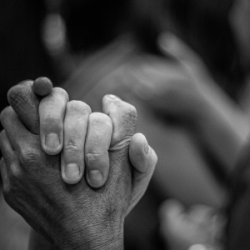Welcome readers! Please subscribe through the buttons at the right if you enjoy this post.

We’ve been discussing the importance of listening to those on the margins of society and their experiences and wisdom. What follows is a result of doing just that in the context of the subject of nonviolence.
So far in this series, we have discussed both nonviolence and resistance. It’s now time to address the difference between nonviolence as self-sacrificial and nonviolence as self-affirming.
Historically, certain forms of nonviolence have tended to drift into victims passively enduring suffering to redeem their oppressors. This is why we must take a moment to clarify the differences between self-affirming nonviolence and the myth of nonviolent, redemptive suffering. Other scholars’ work will help us understand.
Drs. Marcus Borg and John Dominic Crossan write in their book The Last Week: What the Gospels Really Teach About Jesus’s Final Days in Jerusalem:
“Notice, above all, how repeatedly Mark has Jesus insist that Peter, James and John, the Twelve, and all his followers on the way from Caesarea Philippi to Jerusalem must pass with him through death to a resurrected life whose content and style was spelled out relentlessly against their refusals to accept it. For Mark, it is about participation with Jesus and not substitution by Jesus. Mark has those followers recognize enough of that challenge that they change the subject and avoid the issue every time.” (Borg, Marcus J., and John Dominic. Crossan. The Last Week: What the Gospels Really Teach About Jesus’s Final Days in Jerusalem [2007], p. 102.)
Mark’s Jesus speaks of the cross as participatory rather than as substitution. At this point in the story, it was something Jesus invited his disciples to join him in. We must ask ourselves what this means for other Jesus followers in other times and places.
Jesus’s teachings on nonviolence in the sermon on the mount were forms of nonviolent resistance through which his fellow oppressed could stand up to the dehumanizing attempts of their oppressors. They were nonviolent forms of resistance and self-affirmation.
But what we see in the story is Jesus’ suffering of his cross can be interpreted as a passive lack of resistance. If this proves a valid interpretation, then his instruction in the Sermon on the Mount would be distinct from the lack of resistance we see at the cross. His teachings in the Sermon on the Mount and interpreting Jesus’ actions surrounding the cross event as being passive have been conflated to produce harm.
How many domestic violence survivors have had the cross of Jesus and his “patient endurance of suffering” held up to them as something they should emulate? They have been told to “take up their cross” and simply endure: it’s a dangerous situation where they are deemed “Christlike” as they endure abuse for the redemption of their spouse. They are told that this is what it means to follow Jesus’s “example.” So how do we harmonize what he taught and what he did?
Let’s back up and unpack what led up to Jesus’s cross in the story.
In Matthew, Mark, and Luke, the cross is the direct backlash of the elite class in power to Jesus’ protest in the Temple where he overturned the tables and drove out the livestock. Jesus was not “patiently enduring suffering” in his Temple protest. He was resisting. He was protesting. He was shutting it down. And, ultimately, the cross was the result of his resistance. A cross is not the first act of violence that oppressors inflict on the oppressed that we simply must endure. The cross is a secondary act of violence that oppressors impose on the oppressed for standing up to the primary violence. Consider the following chronologies.
Myth of Redemptive Suffering versus Self-affirming Nonviolence
Within the myth of redemptive suffering the recommended chronology of events is:
1) Initial Oppression
2) Our “bearing our cross” which is defined as a patient, passive endurance for the redemption of the violent
Within an interpretation of Jesus teachings as self-affirming nonviolence the chronology of events would be:
1) Oppression
2) Resistance even though there may be a backlash
3) The cross is defined as the violence that is threatened by those in power if one does stand up.
4) The cross is the backlash that must be risked rather than avoided through passive acceptance of initial oppression.
Self-affirming nonviolence is quite different from redemptive suffering. Self-affirming nonviolence is the call to stand up to oppression. Remember Barbara Deming’s statement about the two hands, one held up and one outstretched.
“With one hand we say to one who is angry, or to an oppressor, or to an unjust system, ‘Stop what you are doing. I refuse to honor the role you are choosing to play. I refuse to obey you. I refuse to cooperate with your demands. I refuse to build the walls and the bombs. I refuse to pay for the guns. With this hand I will even interfere with the wrong you are doing. I want to disrupt the easy pattern of your life.’ But then the advocate of nonviolence raises the other hand. It is raised outstretched – maybe with love and sympathy, maybe not – but always outstretched . . . With this hand we say, ‘I won’t let go of you or cast you out of the human race. I have faith that you can make a better choice than you are making now, and I’ll be here when you are ready. Like it or not, we are part of one another.’” (Revolution & Equilibrium. Grossman, 1971. Page 224.)
The cross was the violence that people in power used to threaten those considering standing up to their oppressors. Taking up one’s cross in self-affirming nonviolence is not patient, passive endurance of suffering but the choice to resist and stand up against oppression even if one is threatened with a cross for doing so.
Feminist and womanist scholars criticize theology that equates the cross with patient, passive, endurance of oppression and violence:
“Christian theology has long imposed upon women a norm of imitative self-sacrifice based on the crucifixion of Jesus of Nazareth. Powerlessness is equated with faithfulness. When the cross is also interpreted as the salvific work of an all-powerful paternal deity, women’s well being is as secure as that of a child cowering before an abusive father.” (Joanne Carlson Brown and Carole R. Bohn, Christianity, Patriarchy, and Abuse: A Feminist Critique [1989] p. xii)
“The problem with this theology is that it asks people to suffer for the sake of helping evildoers see their evil ways. It puts concern for the evildoers ahead of concern for the victim of evil. It makes victims the servants of the evildoers’ salvation.” (Ibid. p. 20)
“In this sense Jesus represents the ultimate surrogate figure; he stands in the place of someone else: sinful humankind. Surrogacy, attached to this divine personage, thus takes on an aura of the sacred. It is therefore fitting and proper for black women to ask whether the image of a surrogate-God has salvific power for black women or whether this image supports and reinforces the exploitation that has accompanied their experience with surrogacy.” (Delores S. Williams and Katie G. Cannon, Sisters in the Wilderness: The Challenge of Womanist God-Talk [2013], p. 127)
The Rev. Drs. Joanne Carlson Brown and Rebecca Parker make an important distinction between the myth of redemptive suffering and choosing life in spite of the suffering that may be threatened as a result:
“It is not the acceptance of suffering that gives life; it is commitment to life that gives life. The question, moreover, is not Am I willing to suffer? but Do I desire fully to live? This distinction is subtle and, to some, specious, but in the end it makes a great difference in how people interpret and respond to suffering.” (Brown & Parker, p. 18)
Yes, there are subtle distinctions between defining “taking up one’s cross” as passively enduring oppression and defining it as being willing to stand up and resist even if there are those who threaten you with a cross. But how we define Jesus’s call to take up our cross makes all the difference in how we respond to oppression, violence, and injustice. Does taking up the cross means remaining passive? Or does it mean not letting our oppressors threaten us into remaining passive?
Lastly, the cross is not universally intrinsic to following Jesus, as some would have us believe. It only comes into the picture if one’s oppressors use it as a threat to try to force us to remain passive. The cross is only present if oppressors make it present, and only if the oppressed choose to resist and stand up in spite of being threatened. If those in power do threaten you with a cross for following Jesus and standing up to oppression, then following Jesus involves the cross for you. The cross is secondary and not universal; it is not primary or intrinsic to following Jesus for all.
This leads us to discern what the teachings of a 1st Century Jewish prophet of the poor may offer us today in our contemporary work of survival, resistance, liberation, reparation, and transformation. It’s not the cross that transforms society. Following the teachings of Jesus and standing up to injustice transforms society. So it is not the cross of Jesus that “saves” us societally, but following Jesus saves societally us by placing us on a different path with different intrinsic results. It is, as Brown and Parker state, not the acceptance of suffering that brings life, but the determination to choose life that brings life. Jesus didn’t die so the elite in the status quo could go to heaven at death. Jesus died because he stood up to the status quo in solidarity with the oppressed in spite of being threatened with death for doing so.
In this series on nonviolence, we must head the caution that the Rev. Dr. Katie G. Cannon gave us: nonviolence should not be interpreted as passivity, redemptive suffering, or societal disengagement:
“[Delores Williams] contends that theologians need to think seriously about the real-life consequences of redemptive suffering, God-talk that equates the acceptance of pain, misery, and abuse as the way for true believers to live as authentic Christian disciples. Those who spew such false teaching and warped preaching must cease and desist.” (Delores S. Williams and Katie G. Cannon, Sisters in the Wilderness the Challenge of Womanist God-Talk [2013], Forward)
Williams goes on to quote the scholars we referenced this week, who critique Dr. Martin Luther King, Jr. allowing his own nonviolence to drift into forms of redemptive suffering:
“Their critique of Martin Luther King, Jr.’s idea of the value of the suffering of the oppressed in oppressed-oppressor confrontations accords with my assumption that African-American Christian women can, through their religion and its leaders, be led passively to accept their own oppression and suffering—if the women are taught that suffering is redemptive. Brown and Parker quote Martin Luther King, Jr.’s words about suffering which he saw as a most creative and powerful social force…. The non-violent say that suffering becomes a powerful social force when you willingly accept that violence on yourself, so that self-suffering stands at the center of the non-violent movement and the individuals involved are able to suffer in a creative manner, feeling that unearned suffering is redemptive, and that suffering may serve to transform the social situation. Brown and Parker’s critique of this theology ‘is that it asks people to suffer for the sake of helping evildoers see their evil ways. It puts concern for the evildoers ahead of concern for the victim of evil. It makes victims the servants of the evildoers’ salvation.’” (Ibid.. p. 161.)
One of King’s most famous sermons drifts into the myth of redemptive suffering or nonviolence defined as the self-sacrifice of the oppressed rather than self-affirmation:
“I’ve seen too much hate to want to hate, myself, and every time I see it, I say to myself, hate is too great a burden to bear. Somehow we must be able to stand up against our most bitter opponents and say: ‘We shall match your capacity to inflict suffering by our capacity to endure suffering. We will meet your physical force with soul force. Do to us what you will and we will still love you. We cannot in all good conscience obey your unjust laws and abide by the unjust system because non-cooperation with evil is as much a moral obligation as is cooperation with good, so throw us in jail and we will still love you. Bomb our homes and threaten our children, and, as difficult as it is, we will still love you. Send your hooded perpetrators of violence into our communities at the midnight hour and drag us out on some wayside road and leave us half-dead as you beat us, and we will still love you. Send your propaganda agents around the country and make it appear that we are not fit, culturally and otherwise, for integration, but we’ll still love you. But be assured that we’ll wear you down by our capacity to suffer, and one day we will win our freedom. We will not only win freedom for ourselves; we will appeal to your heart and conscience that we will win you in the process, and our victory will be a double victory.’” (in Martin Luther King, A Gift of Love: Sermons from Strength to Love and Other Preachings [2012], p. 54)
There is a subtle difference between the above passage and the passage we read previously from Barbara Deming. Jesus’ teachings in the Sermon on the Mount did not call his followers to passively respond to suffering but to stand up to injustices in nonviolent forms of resistance.
Both feminist and womanist authors warn of defining Jesus’ cross (when interpreted as passive acceptance) rather than his teachings as the centerpiece of our nonviolence. Again the cross did not demonstrate Jesus’ nonviolence. It was the backlash for Jesus’ previous nonviolent resistance.
Consider Delores Williams’ words, one more time:
“It seems more intelligent and more scriptural to understand that redemption had to do with God, through Jesus, giving humankind new vision to see the resources for positive, abundant relational life. Redemption had to do with God, through the ministerial vision, giving humankind the ethical thought and practice upon which to build positive, productive quality of life. Hence, the kingdom of God theme in the ministerial vision of Jesus does not point to death; it is not something one has to die to reach. Rather, the kingdom of God is a metaphor of hope God gives those attempting to right the relations between self and self, between self and others, between self and God as prescribed in the sermon on the mount, in the golden rule and in the commandment to show love above all else.” (Delores S. Williams and Katie G. Cannon, Sisters in the Wilderness the Challenge of Womanist God-Talk [2013], p. 130-131)
As we close, let’s revisit Elizabeth Bettenhausen’s account of a conversation with a group of seminarians. It gives us much to ponder about whether Jesus’ nonviolence was rooted in the self-affirmation of the oppressed found in the instruction in the Sermon on the Mount or should be defined as the oppressed’s self-sacrifice—their cross:
“Several years ago I asked a group of seminarians to choose New Testament stories about Jesus and rewrite them imagining that Jesus had been female. The following recreation of the passion story of Luke 22:54-65 was one woman’s knowing by heart.
‘They arrested the Christ woman and led her away to the Council for questioning. Some of her followers straggled along to find out what was to become of her. There were seven women and two men followers. (The men followers were there mainly to keep watch over their sisters.) Someone from among the crowd asked a question of a man follower, “Haven’t I seen you with this woman? Who is she, and what is your relationship with her?” He replied defensively, “She is a prostitute, she has had many men. I have seen her with many!” The men who were guarding the Christ [woman] slapped her around and made fun of her. They told her to use magic powers to stop them. They blindfolded her and each them in turn raped her and afterward jeered, “Now, prophetess, who was in you? Which one of us? Tell us that!” They continued to insult her.’ (Kandice Joyce)
After this story was read aloud, a silence surrounded the class and made us shiver. Ever since, I have wondered Would women ever imagine forming a religion around the rape of a woman? Would we ever conjure gang-rape as a salvific event for other women? What sort of god would such an event reveal?” (in Joanne Carlson Brown and Carole R. Bohn, Christianity, Patriarchy, and Abuse: A Feminist Critique [1989], p. xi-xii)
Again, the cross was the result of Jesus’ refusal to let go of his hold on life and the lives of those he stood in solidarity within the face of the oppression, violence, and injustice of his day. The cross proves Jesus was not content to remain passive and politically disengaged. We have seen in this series that Jesus’ teachings on nonviolent resistance were a means of marginalized groups affirming their selves, their humanity, and the value of their lives. It was not more than resistance. It was more than nonviolent. It was nonviolent resistance that at its heart was an act of self-affirmation.

















